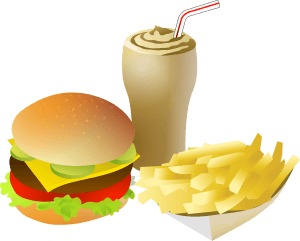You’re starving.
You’re running late.
You spy your favorite fast-casual restaurant en route to your next errand and before you can say, “I’ll have the #3 combo with extra tomato please”, you whip into the parking lot, jockey for position, and creep toward that magical drive-through window bearing your lunch.
And you’re not alone.
During spring 2017, 219.46 million people visited fast-food restaurants (yes, Panera/Chipotle/Potbelly/Starbucks are considered fast “casual” food) within a period of 30 days. (1)
It’s a habit you try to avoid – grabbing food on the run – especially since your breast cancer diagnosis. You try really hard to eat as healthfully as you can, as often as you can, but sometimes, life just gets in the way.
You’re chauffeuring kids everywhere or helping them with a never-ending list of projects/homework assignments, running a million errands for work AND home, and juggling obligations to friends, family and beyond. Who has time to cook?
Which also means, there are the occasional days when everyone living under your roof is the beneficiary of a take-out meal. I know you think I’m talking “burgers and fries” (of course you wouldn’t DREAM of bringing that home), but I mean ANYTHING (pizza, grocery store hot food bar, a deli platter, your favorite noodle shop) pre-made that you pick up to bring home and feed those hungry folks lying in wait.

I’ve long been a proponent of cooking at home more often than eating out – even before my own breast cancer diagnosis. I don’t deny, nor apologize for my strongly-held position on that, and I work really hard to help people figure out the best/easiest/most convenient way for them to eat IN vs OUT on any given day.
I know it takes effort. I realize it takes planning. I absolutely acknowledge it takes time.
And I think it’s worth it.
Especially now, in light of new research highlighting hidden health risks (I’m not being dramatic, they ARE hidden) associated with dining out that go beyond the sub-optimal nutritional value you may think I’m getting at.
Show Me The Study
A study out just this week found a connection between dining out (which in this instance refers to restaurants, cafeterias and fast-food outlets) and increased exposure to harmful chemicals called phthalates; known hormone disruptors linked to a long list of health problems that may include breast cancer. (2, 3)
From an article I wrote in 2008 on the safety of plastic bottles and containers: “Phthalates are a chemical used to make hundreds of products, including toys, vinyl flooring and wall covering, shower curtains, detergents, lubricating oils, food packaging (e.g. some plastic wraps), pharmaceuticals and medical supplies, and personal care products such as nail polish, hair spray, soap and shampoo. Phthalates make vinyl and other plastics soft and pliable, nail polish chip resistant, and slow the evaporation of perfume fragrances.” (4)
Researching that article changed my life.
I emptied cabinets of excess plastic storage containers (especially for food), stocked up on snap-lidded glassware, swapped out every beauty and personal care item for a toxin-free version (including those my husband uses), began purchasing only chemical/toxin-free cleaning and laundry supplies (or made my own), banned the #7 BPA-riddled Hinckley Springs water cooler from my office, and tossed every promotional plastic mug we’d ever collected.
And don’t even get me started on styrofoam.
Let’s just say I became hyper-aware of anything containing (or potentially containing) BPA, phthalates or other chemicals and their contact with the sustenance I put into my body – especially HOT food and beverages. Heat can accelerate leaching of chemicals from dish and serving ware into the food or beverage you’re consuming. (5)
And that’s the issue this study brings to light. Many products used to prepare and serve your dining out meal contain phthalates, including but not limited to: take-home boxes and cups, gloves used in food handling, and food processing, production and storage items such as plastic containers and plastic wrap. Previous research suggests chemicals can leach from these plastic containers and wrappers into the food, and although this particular study didn’t specifically reference food DELIVERY, several studies have detected phthalates in food delivery boxes, particularly of the pizza variety. (5,6)

According to this study, which compared phthalate exposures in people who reported dining out to those more likely to eat home-cooked meals, phthalate levels were nearly 35 percent higher in people who consumed more restaurant, fast-food and cafeteria meals.
And this was no small study. Using data from the National Health and Nutrition Examination Survey (NHANES) collected between 2005 and 2014, the authors asked 10,253 participants to recall what they ate and where their food came from in the previous 24 hours; they determined that 61 percent of the participants reported dining out the previous day.
Analyzing links between foods eaten and the levels of phthalate break-down products present in each participant’s urine sample, they found that the association was highest for teenagers, and adolescents who were high consumers of fast-food and other food purchased outside the home had 55 percent higher phthalate levels compared to those who only consumed food at home. (7)
This last bit is especially concerning, given that some scientific literature suggests early exposure to phthalates in prepubescent girls may be connected to breast cancer risk later in life. (8)
REALITY CHECK
Ok, now that I’ve thrown all this at you, let’s take a collective deep breath.
Please know that I’m not suggesting you NEVER eat out. That’s unrealistic and un-fun, not to mention, impossible. I mean, how could you possibly travel and NOT eat out?
What I am suggesting, is that you take stock of how often you eat food prepared by someone other than yourself, in a (commercial) kitchen other than your own, and include EVERYTHING; breakfast, lunch, snack with your coffee, dinner, appetizers and drinks with the girls, movie theater munchies, intermission nibbles at cultural performances, the snack/alcohol bar at sporting events, museum outings, the buffet of snacks at day-long professional meetings, your book club, or the volunteer planning event. The list is ENDLESS, because you can eat endlessly EVERYWHERE!
Now, is there any place you can reduce that number you came up with? Can you walk to the pantry or fridge and scrounge something up? Can you grab quick fixin’s at the grocery store so you can effortlessly assemble a sandwich, heat up a bowl of soup, or munch on hummus, crackers and fruit? And you know, cereal really can count as dinner.

No need to get all cra-cra about it, but do realize that most pre-prepared foods have had some level of chemical exposure along their production journey (honestly, you could say that about ALL food – hello pesticides and injected hormones!), and once they land on your plate, so will you.
My intention is not to come off as alarmist or the dietitian dining police; this is a real thing! My only goal is to educate you on this stuff – you can do with it whatever you please, yet if you’re interested in reducing toxins in your environment, you probably want to know every place they may be hiding. It’s empowering to have all the knowledge you can get, especially since breast cancer is so random and so all about not feeling in charge of your life. If you choose, eating out less often is something you can be in charge of – and that typically feels pretty darn good.
A few closing stats to chew on:
- In 1955, the restaurant industry comprised 25% of the family food dollar. In 2017, that number rose to 48%.
- 51% of diners go out to eat more than once a week.
- 70% of diners say they are more likely to choose a restaurant that offers healthy menu options. (Yay, at least there’s that!). (9)
Like what you read? Never miss another post! Click here, sign up for my newsletter, get a FREE gift!
SOURCES
(2) Dining out associated with increased exposure to harmful chemicals
(3) Large new study of phthalate exposure and breast cancer risk
(4) Are Plastic Bottles and Containers Safe?
(5) A Hard Nut to Crack: Reducing Chemical Migration in Food-Contact Materials
(8) Fact Sheet for Health Professionals: Early Puberty and Breast Cancer Risk
(9) 50+ Restaurant Industry Statistics for Restaurant Owners in 2018

